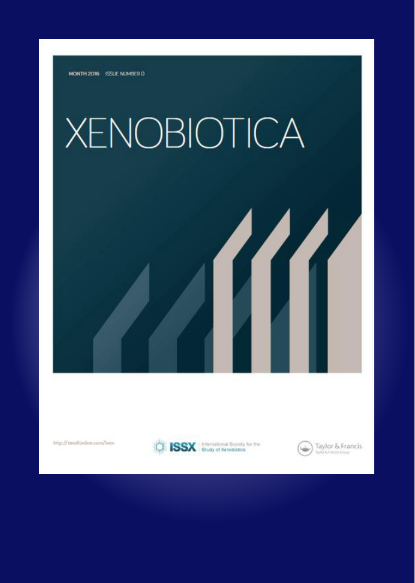Elucidating the structure and cytochrome P450-mediated mechanism for novel metabolites of GDC-0575 in rats
IF 1.2
4区 医学
Q4 PHARMACOLOGY & PHARMACY
引用次数: 2
Abstract
Abstract 1. GDC-0575 is an ATP-competitive small-molecule inhibitor of ChK1 that is being developed by Genentech for the treatment of various human malignancies. 2. In a radiolabeled mass balance study of GDC-0575 in rats, two novel metabolites, named M12 (-71 Da,) and M17 (+288 Da), were detected as abundant circulating metabolites. 3. Subsequent mass spectrometry and nuclear magnetic resonance analysis showed that M12 was a cyclized metabolite of GDC-0575, whereas M17 was its heterodimer to the parent. We further determined that M12 was mainly generated by cytochrome P450 (Cyp) 2d2. 4. We proposed the potential mechanism was initiated by the oxidation on the pyrrole ring and subsequent cyclisation of the free primary amine onto C-3 of the pyrrole ring. This was followed by expulsion of cyclopropylcarboxamide and a loss of water to form intermediate I, which can be further oxidised to form M12, or dimerise with another molecule of GDC-0575 as nucleophile to form M17. 5. To verify this hypothesis, we attempted to trap the intermediate I with glutathione (GSH) trapping assay and the GSH conjugate on the pyrrole ring was identified. This suggests the oxidation on the pyrrole led to reactive metabolite formation and supported this proposed mechanism.阐明大鼠GDC-0575新代谢产物的结构和细胞色素p450介导的机制
抽象的1。GDC-0575是一种atp竞争性ChK1小分子抑制剂,由Genentech公司开发,用于治疗各种人类恶性肿瘤。2. 在对大鼠GDC-0575的放射性标记质量平衡研究中,检测到两种新的代谢物M12 (-71 Da)和M17 (+288 Da)是丰富的循环代谢物。3.随后的质谱和核磁共振分析表明,M12是GDC-0575的环化代谢物,而M17是其与亲本的异二聚体。我们进一步确定M12主要由细胞色素P450 (Cyp) 2d2产生。4. 我们提出可能的机制是由吡咯环的氧化和随后游离伯胺在吡咯环的C-3上的环化引起的。随后是环丙基羧酰胺的排出和水的损失,形成中间体I,中间体I可以进一步氧化形成M12,或与另一个GDC-0575分子作为亲核试剂二聚形成M17。5. 为了验证这一假设,我们尝试用谷胱甘肽(GSH)捕获法捕获中间体I,并在吡咯环上鉴定了谷胱甘肽偶联物。这表明吡咯的氧化导致了反应性代谢物的形成,并支持了这一机制。
本文章由计算机程序翻译,如有差异,请以英文原文为准。
求助全文
约1分钟内获得全文
求助全文
来源期刊

Xenobiotica
医学-毒理学
CiteScore
3.80
自引率
5.60%
发文量
96
审稿时长
2 months
期刊介绍:
Xenobiotica covers seven main areas, including:General Xenobiochemistry, including in vitro studies concerned with the metabolism, disposition and excretion of drugs, and other xenobiotics, as well as the structure, function and regulation of associated enzymesClinical Pharmacokinetics and Metabolism, covering the pharmacokinetics and absorption, distribution, metabolism and excretion of drugs and other xenobiotics in manAnimal Pharmacokinetics and Metabolism, covering the pharmacokinetics, and absorption, distribution, metabolism and excretion of drugs and other xenobiotics in animalsPharmacogenetics, defined as the identification and functional characterisation of polymorphic genes that encode xenobiotic metabolising enzymes and transporters that may result in altered enzymatic, cellular and clinical responses to xenobioticsMolecular Toxicology, concerning the mechanisms of toxicity and the study of toxicology of xenobiotics at the molecular levelXenobiotic Transporters, concerned with all aspects of the carrier proteins involved in the movement of xenobiotics into and out of cells, and their impact on pharmacokinetic behaviour in animals and manTopics in Xenobiochemistry, in the form of reviews and commentaries are primarily intended to be a critical analysis of the issue, wherein the author offers opinions on the relevance of data or of a particular experimental approach or methodology
 求助内容:
求助内容: 应助结果提醒方式:
应助结果提醒方式:


